Read Ancient Aliens on the Moon Online
Authors: Mike Bara
Ancient Aliens on the Moon (16 page)
Some subsequent reports have sought to downplay these comments by Wilkins, and to assert that he was quite reserved about the possible artificial nature of the bridge that he and O’Neill both observed. But, a review of the transcript of the interview shows that is not the case and he was quite forceful about the probable artificial nature of the structure:
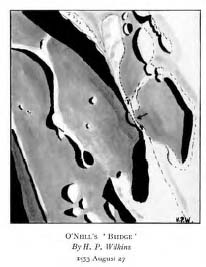
Illustration of the “Crisium Bridge” by H.P. Wilkins.
[Brian Forbes —Host] “Since the beginning of this Century, astronomers have been observing features on the surface of the Moon which have not been noticed before. During the last few years, many dome-like swellings have been seen through powerful modern telescopes. And only a few months ago, astronomers detected what is perhaps the most curious feature of all. It looks like a gigantic bridge. The Director of the British Astronomical Association— Dr. H.P. Wilkins—when interviewed, discussed this new discovery.
[Wilkins] If you look through the eyepiece, you will see one of the most interesting regions on the Moon… called the Mare Crisium. It’s that comparatively small, dark oval marking.
[Forbes] Yes… I can see it now.
[Wilkins] I’ve mentioned this gap in the mountain barrier… but there now exists what looks like a bridge across this gap.
[Forbes] That’s most extraordinary.
[Wilkins] Now this is a real bridge. Its span is about 20 miles from one side to the other. And it’s probably at least 5,000 feet-or-so from the surface beneath.
[Forbes] It must be a most gigantic arch if it’s 5,000 feet high.
[Wilkins] It certainly is.
[Forbes] How wide is it?
[Wilkins] The width is about a mile-and-a-half to 2 miles. It tapers —narrows, rather—in the center.
[Forbes] Are you quite certain that you haven’t mistaken it for some other object?
[Wilkins] Oh no, there’s no mistake at all. It’s been confirmed by other observers. It looks artificial. It’s almost incredible that such a thing could have been formed in the first instance or—if it was formed—could have lasted during the ages in which the Moon has been in existence. You would have expected it either to be disintegrated by temperature variations or by meteor impact.
[Forbes] And when you say it looks ‘artificial’, what do you mean exactly by that?
[Wilkins] Well, it looks almost like an engineering job.
[Forbes] {exclamation of astonishment}
[Wilkins] Yes, it is more extraordinary.
[Forbes] And is it more-or-less ‘regular’ in outline?
[Wilkins] Absolutely regular in outline. That makes it all the more remarkable.
[Forbes] And does it cast a shadow?
[Wilkins] Yes, it casts a shadow under a low Sun. You can see the sunlight streaming in beneath it.”
6
The next day, brief cable reports on Wilkins’ broadcast appeared in U.S. papers, but other than that it was apparently ignored. However, scientific sentiment against Wilkins quickly turned form curiosity to ridicule and he was eventually forced to resign from the British Astronomical Association because of his support of O’Neill’s claims. He died a few years later in 1960, having never withdrawn his claims about the bridge in Mare Crisium.
Today, the general consensus is that both O’Neill and Wilkins were mistaken in their observations, the victims of an optical illusion that was never confirmed by other sources. This however ignores Wilkins own statements made in the BBC interview that “It’s been confirmed by other observers.” Meaning that, others besides himself and O’Neill had seen the structure too. Given the way in which Wilkins career was destroyed by his assertions, it’s easy to see why these “other observers” have never come forward publically.
All of this serves as background for a number of more substantial discussions of other, far more interesting anomalies through the Crisium region. Most specifically those on NASA frame AS16-121-19438.
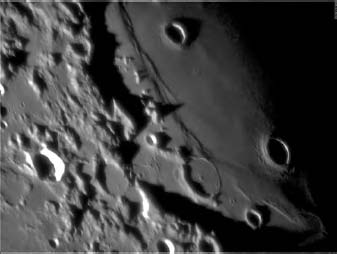
Area thought to be the Mare Crisium Bridge today.
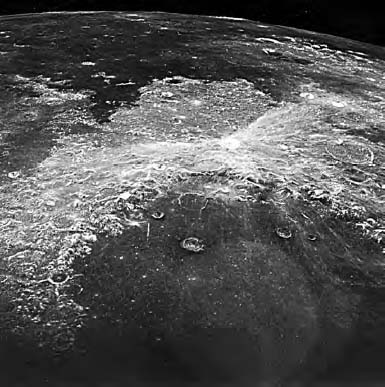
AS16-121-19438.
At first glance, AS16-121-19438 doesn’t seem all that unusual or even interesting. Like a lot of shots of the Moon from orbit, it seems to show a fairly normal display the usual craters and highlands, dark maria and mountains. But then you start to notice the details.
For one thing, this Apollo 16 shot (the “AS16” in the frame number means it is an Apollo-16 photograph) contains a remarkable object right next to the crater Picard; a shimmering, vertical spire of glass very similar to the “Tower” in Sinus Medii. But there are also differences between the two objects.
First off, this “Crisium spire” is not only hundreds of miles it height, it is clearly (and obviously) supported by what appear to be guy wire like beams attached to it at several points along the vertical structure of the object. These luminescent support struts not only attach to the spire in logical places along its vertical axis, but they do so evenly on both sides. This symmetry is a tell-tale sign of engineering design intent, rather than some sort of optical illusion or natural phenomenon. The Crisium Spire also differs from the Shard and Tower in Sinus Medii in that is not, like them, anchored to a spot on the surface but rather appears to be suspended miles-high
above
the Mare Crisium plane, much like the Castle in Sinus Medii.
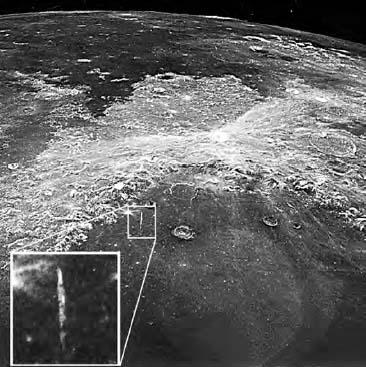
The “Crisium Spire” from AS16-121-19438 (inset).
Further inspection in close up implies that the Spire is a corner post of what may be a large, box shaped structure stretching miles above the Mare Crisium plane. It looks very similar to the complex, box-like scaffolding seen in Sinus Medii in NASA frame AS10-32-4816.
But the goodies in this image of Mare Crisium hardly stop there. A closer inspection of the Spire shows that right next to it is the crater Picard, a distinctive feature in its own right. In most images, Picard looks for all the world like a perfectly normal impact crater (except for possibly the lack of a visible ejecta blanket). But in this image, it takes on the stark appearance of having a shattered glass dome partially covering it.
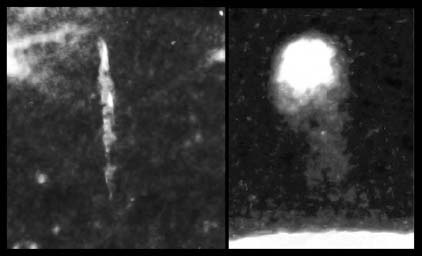
The Spire and the Tower side-by-side.
This unmistakable, pie-slice shaped structure glows in the sunlight, illuminating what must be the last remaining piece of a solid, watch-crystal like dome over the crater itself. Under intense enhancement, the wedge-shaped pie piece is even more obvious.
Also visible in the original enhancement are a series of parallel, dark striations along the northern rim of the crater itself. What these could be caused by is a bit of a geologic mystery.

Support wires emanating from the Spire at 90° angles.
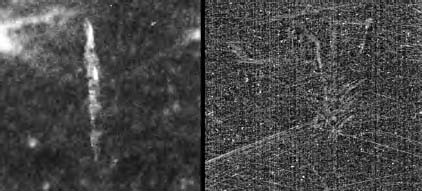
Comparison of box-like structures above the lunar surface.
Unfortunately, there are precious few other photos of Picard at the correct angle to provide comparison. One research group calling itself VGL (for Verified Gullible LUNAtics) has found one shot taken at an oblique angle—AS10-30-4421. In this image, Picard is seen from the side in a photo taken from a low angle by the Apollo 10 crew as the command module Charlie Brown flew past (not
over)
Mare Crisium in May, 1969. The first thing that is notable to me about the photo is a sort of gauzy haze which seems to be between the camera and the crater, much like Apollo 15 commander Al Worden’s describes at the beginning of the chapter. According to VGL’s analysis, they also noticed this odd haze. According to their report
7
“This could be an illusion caused by the similarity of brightness and texture between the mare surface at the rim and the inner wall of the crater behind this indistinct section of the rim… It might, however, be a true obscuration of the rim by debris suspended above the mare surface between the camera and the rim of Picard.”
